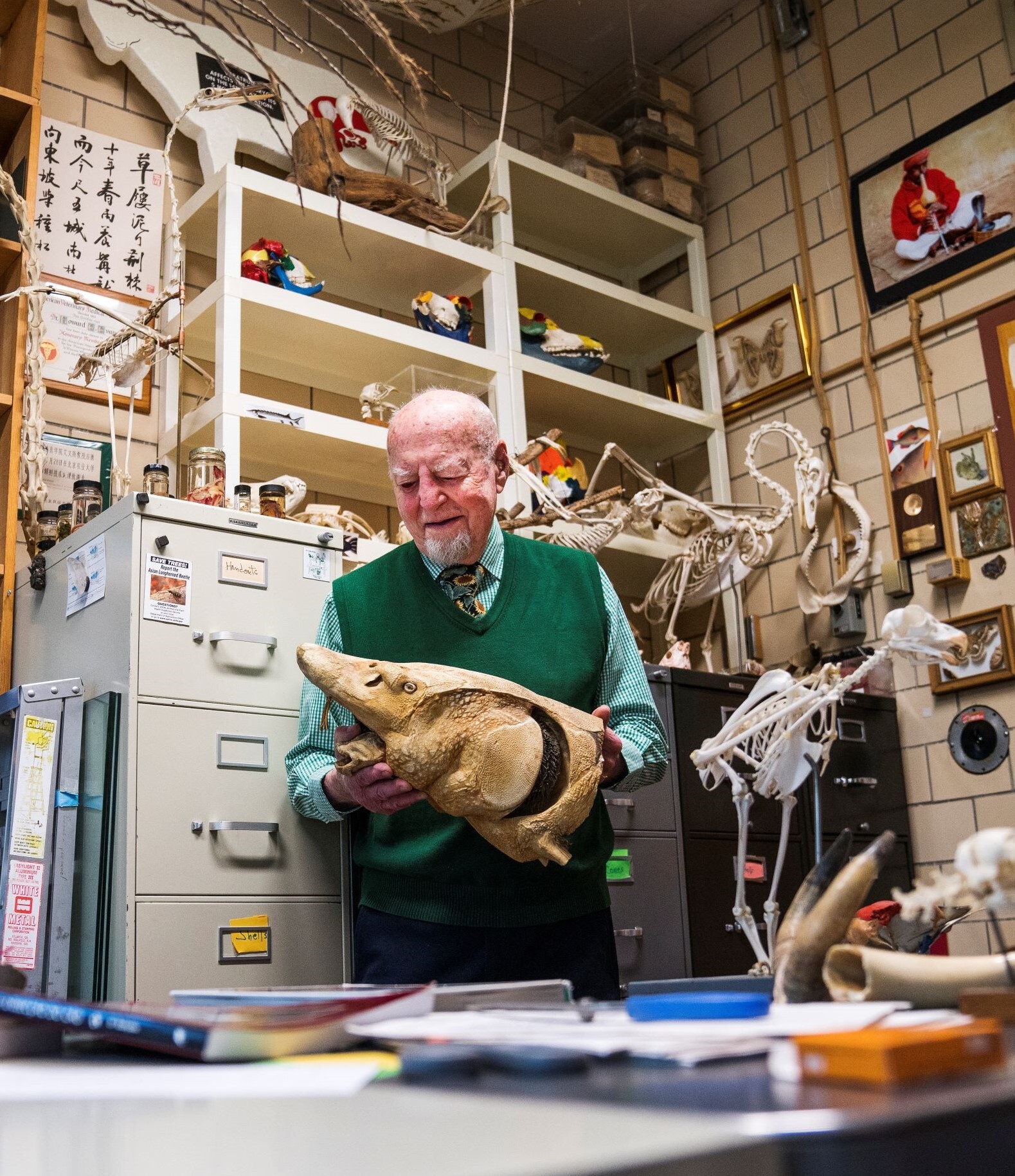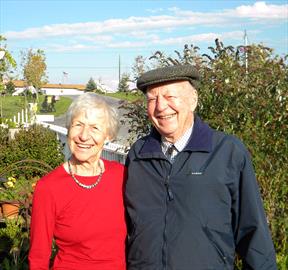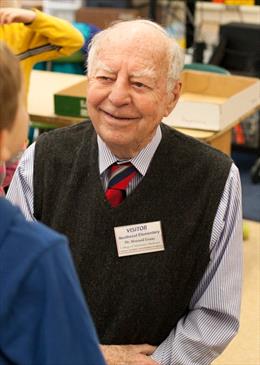Dr. Howard Evans

Cornell University photo
Howard Evans holds a specimen in his office at the Cornell University School of Veterinary Medicine.
 Listen to this story.
Listen to this story.
One of the things Dr. Roy Pollock remembers most about a trip to Madagascar with his former veterinary anatomy professor and friend Howard Evans in 2007 didn't happen in the countryside but at the airport. "As we were waiting in line for customs, a huge insect flew into the arrivals hall," Pollock remembered. "Howard managed to catch it and popped it into a specimen jar he had in his pocket. He rarely traveled without one."
This memory of a curious man, keen to know the natural world and prepared to grab with gusto every opportunity to do so, is one of the many reminiscences shared by family, friends and colleagues since news spread that Evans had died on June 20 at the age of 100.
An emeritus professor of veterinary and comparative anatomy at Cornell University School of Veterinary Medicine, Evans is remembered as an influential veterinary educator with a deep understanding of comparative anatomy, a lifelong learner, a consummate storyteller and an all-around great guy.
Evans taught the anatomy of birds, cows, dogs, fish and horses for 36 years to thousands of veterinary students, including three former Cornell veterinary school deans, before retiring in 1986.
He also co-authored several foundational textbooks, including Guide to the Dissection of the Dog and Miller and Evans' Anatomy of the Dog.
In 1970, Evans, who had a doctorate in comparative anatomy, was elected an honorary member of the American Veterinary Medical Association. One of a coterie of non-veterinarians to receive the honor, he was also the last. The AVMA eliminated honorary memberships a few years later.
Being accepted by the veterinary profession as one of its own was "one of the things he was most proud of," Evans' son Ed told the VIN News Service this week.
In addition to Ed, Evans is survived by a brother, Martin; wife of 74 years, Erica; daughter, Gail; and four grandchildren and eight great-grandchildren.
Urban naturalist
Evans grew up on New York City's Upper West Side. He followed a naturalist bent from an early age at Boy Scout camp and at the American Museum of Natural History, where he had an after-school job.
In an oft-told story, he said he was inspired as a teenager to attend Cornell University by a conversation with an exterminator who told him that there was a school in upstate New York that had a building with three floors where "people are looking through microscopes at bugs." Evans enrolled in Cornell's New York State College of Agriculture to study entomology in 1940.
John Hermanson, an associate professor emeritus of anatomy at the veterinary school, recounted how the "city kid" faced some unexpected speed bumps early on. For one course, "he had to prove he could work on a farm," Hermanson said. That included putting a bridle and harness on a draft horse "that was twice his size." The effort knocked Evans to the ground. According to the story, the instructor looked at the flattened Evans and said, "You've never done this before, have you?"
As an ROTC student, he was called to active duty in World War II at the end of his sophomore year, serving from 1943 to 1946. He was awarded a bachelor's degree in absentia in 1944. Upon his discharge from the Army, he returned to Cornell, where he earned his PhD in 1950 and joined the faculty of the veterinary school.
Dr. Howie and Erica Evans

Photo by Ed Evans
Howard and Erica Evans on Martha's Vineyard in 2012. The couple were a dynamic and beloved pair for 74 years, according to friends.
By many accounts, he was a gifted lecturer.
"He was an incredibly charismatic storyteller," said Dr. Chris Murphy, professor emeritus of comparative ophthalmology at the schools of medicine and veterinary medicine at the University of California, Davis. "Anatomy as a standalone topic is boring. But by the time you were done listening to his lectures, you wanted to become an anatomist."
Murphy pursued his BS, DVM and PhD at Cornell, completing the latter two degrees in the mid-1980s. Evans was Murphy's doctoral adviser. "I lived through six years of full-time Howie Evans," he said. "At no point was he not engaging."
Dr. Eric Glass, a veterinary neurologist in New Jersey, said Evans' enthusiasm was infectious, even if he was just talking about a "simple" radius, ulna or skull.
"You got so excited as a student just listening to him," Glass said, "because he loved learning and he loved sharing his knowledge, but in such a humble way."
Humility and kindness were traits remarked on by several friends and colleagues.
Cornell provost Dr. Mike Kotlikoff described Evans as "a great citizen." He said, "I never heard Howie have a bad word for anyone. He was a fabulous colleague who respected others. No hubris. Very little ego, despite all of his accomplishments."
When Kotlikoff first met Evans in 2000, the anatomist's sense of fun was on full display. Evans and his wife, Erica, were leading an egg-drop competition for the Ithaca community, in which participants created contraptions to prevent eggs dropped from a third-story window from cracking.
Hermanson captured the spirit of Evans' priorities in a recorded conversation with the emeritus professor in 2012. He remembered his 1986 interview for a faculty post at the veterinary school. He'd already gone through the process at a couple of other schools. He described those meetings as formal and focused on salary and responsibilities.
Then he said to Evans: "I came here, and you drove me around, and you took me to the Cornell orchard. You said, 'John, here's the reason you come to Cornell — you get a free apple every day.' " Pay did not come up; Evans' pitch was, "We're all happy here."
Collector, prankster
Glass remembered being invited as a student by Evans to go fossil hunting at Taughannock Falls, outside of Ithaca. "I thought, 'What kind of fossils am I going to find here?' " Glass said. "And sure enough, we just started digging in some rock slate, and there were tons of fossils. And he got so excited by even the slightest fern that we found."
Those fossils joined countless flora, fauna and rock specimens in Evans' office. From lamprey heads and walrus tusks to the gills of a shark, the collection was drawn from all over the world, some during stints as a visiting professor in Australia, China, Grenada, Japan, South Africa, Taiwan and Zimbabwe.
"You'd go into his office, and there were hundreds, if not thousands, of specimens of skeletons and skulls and animals that were preserved. It was as if you were in a museum," Murphy said. "He would just look at something, pick it up and start talking [about it], as though it was the most important specimen, with such detail that you were just blown away and captivated by his enthusiasm."
Visiting Evans' office was a favorite activity for many faculty, students and alumni. Pollock said Evans always had something new to share and was a bit of a prankster.
There was, for example, the piece of boiled pasta in alcohol in a specimen jar. "He would show it to visitors and ask them to speculate on what it was," Pollock said. "Since it was in his office, they assumed it was some sort of plant or animal. He got all sorts of answers, reaching from a mollusk to a fungus."
Ed Evans described growing up in a home that was equal parts zoo and science center. On the side of the garage was a room called the Fish House, where taxidermy animals crowded counters, stuffed birds hung from rafters, and drawers brimmed with specimens of every order and scientific publications.
At one point, Ed said, the family had a peacock "that used to call female wild turkeys down during mating season," a pair of budgerigars, a goat named Suzie, several dogs in succession and a cat. Evans kept a diamondback rattlesnake at the office. According to family lore, he caught the snake as a baby while at Army training camp in Texas. He spotted it, took off one of his socks and slipped the snake inside. It lived to the ripe old age of 19. Its skeleton endures at the veterinary school.
Dr. Howard Evans

Cornell University photo
In retirement, Evans brought his famous specimens and captivating stories of the natural world to elementary schools in the Ithaca, New York, area.
While they were youngsters, Ed and his sister Gail often accompanied their dad to his office, where he would have them sort anything natural. Ed remembers picking through the rattlesnake's excrement for fangs, which it shed and swallowed regularly.
Evans kept a net, specimen jars, preservative and rock hammers in his car, and family vacations were punctuated with frequent stops to collect specimens of one kind or another.
"His world was the vet school, Cornell University and all things natural science," his son said.
Impact on veterinary medicine
"You can't even calculate what he's contributed to veterinary medicine. Yet he wasn't even a veterinarian," Glass marveled. "I work at least 18 hours a day as a busy clinician, writing and doing research, I could live 100 lives, yet I wouldn't contribute as much as Howie Evans has to veterinary medicine."
Murphy called him "a giant in the field," and speaking of the Anatomy of the Dog, he said, "I don't think you'll see a book of that caliber and completeness emerge in the next 100 years."
Both the dog anatomy and dissection guides have been translated into many languages.
Evans also contributed to other books, manuals and monographs on the anatomy of the budgerigar, ferret and woodchuck, as well as reptiles and tropical fish.
His research included fetal development in dogs. He also helped discover that a plant induced cyclopia, the development of only one eye or fused eyes, in fetal lambs. The culprit was the corn lily, also known as false hellebore (Veratrum californicum), when eaten by pregnant ewes on the 14th day of gestation. Newborns with cyclopia usually do not survive for long.
Evans served as president of both American and world associations of veterinary anatomists and was an associate editor of the American Journal of Anatomy and the Journal of Morphology.
Taught all ages
Retirement did not really slow Evans. He was often in his office. At 85, he taught a one-credit elective to veterinary students on natural history. At 93, he, along with his decades-long collaborator Dr. Alexander de Lahunta, revised the Guide to the Dissection of the Dog. De Lahunta died in 2021 at age 88.
Evans' reach only expanded with the years. With his wife, Erica, he led 30 excursions for Cornell alumni around the world. "His wide-ranging interests and encyclopedic knowledge made him wonderful fun to travel with," Pollock said.
Closer to home, he would take baskets of specimens to Ithaca-area public elementary schools regularly to entrance a new generation.